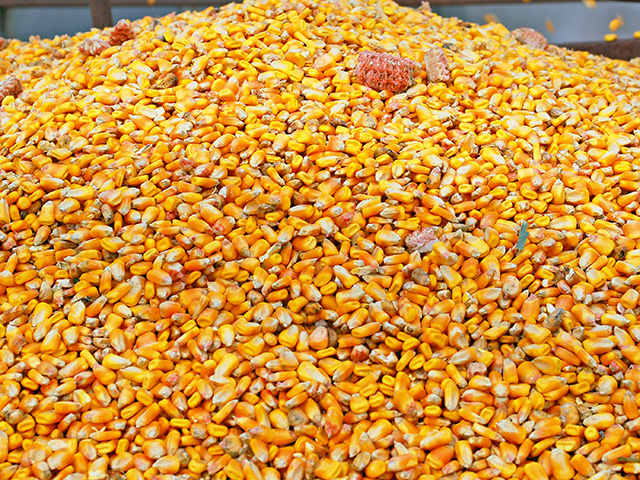Beware Bin Pests
Managing Grain Bin Pests Helps Preserve Profits
OMAHA (DTN) -- Producers need to keep a close eye on stored grain as damage from insect feeding will cut into profit when it is marketed. Identifying these insects and managing them accordingly is essential for those with grain in the bin.
These were the observations of South Dakota State University (SDSU) Extension field crop entomologist Adam Varenhorst in a recent SDSU Crop Hour preview webinar. The weekly webinars are put on by SDSU through the last week of March on various ag-related subjects (https://extension.sdstate.edu/…).
PREVENT INSECT FEEDING
Varenhorst said the best way to avoid insects feeding on grain is to prevent conditions in which insects like to feed. Producers can limit the number of insects in stored grain by following basic rules of grain storage, Varenhorst said, such as never storing new grain on old grain, keeping the grain cool, and applying pre-binning insecticide or a protectant insecticide at binning.
Other practices that can help limit pests in stored grain include cleaning the bin before filling it, sealing areas around bin doors, cleaning grain spills around bins and keeping the bin perimeters clear, he said.
Storing grain at a proper moisture is the most important preventative practice, Varenhorst said.
Corn, for instance, can be stored at 15.5% moisture if the grain is going to be stored short term, which would be three to six months. If corn is going to be stored longer term (a year or more), it must be dried down to 13.5% moisture for it to remain in good condition, he said.
"The moisture should be monitored on a pretty regular basis," Varenhorst said. "About every time you go to scout the bin, you should also be checking for insects as well as the moisture levels."
DIRECT VS. INDIRECT DAMAGE
Varenhorst said there are two types of insect damage in stored grain, direct and indirect.
An example of indirect damage is the presence of insect bodies in the grain. This could contaminate the grain and lead to dockage, he said.
Direct damage is insects feeding on the grain itself, causing damage to the grain. Reduced-quality grain can lead to heat damage, mold growth and odors.
P[L1] D[0x0] M[300x250] OOP[F] ADUNIT[] T[]
Direct feeding leads to declines in germination, nutrition, weight and market value of the grain are all effects of insects directly feeding on grain, he said.
Varenhorst said direct feeding damage can be further broken up into two different groups: internal and external feeders.
INTERNAL FEEDERS
Internal feeders get into the grain by boring holes into it. This damage can happen very quickly and can be very destructive, he said.
There are several examples of internal-feeding grain insects. Among the most common are granary weevil, maize weevil, rice weevil and lesser grain borer.
Varenhorst said each pest has distinct features and feeds slightly differently on the stored grain.
The granary weevil (also known as the wheat weevil) has a long snout with a polished red body. Both the larvae and adults feed on the grain, he said.
Maize weevils are slightly larger than other internal-feeding species, with a densely pitted thorax. The larvae feed on the grain.
Rice weevils are smaller pests that feed within the grain. Their lifecycles need high moisture or high humidity in storage bins to allow them to grow, he said.
The lesser grain borer is also common in stored grains, and its presence causes a sweet or musty odor. Often, their thin, brown body shells are found in stored grain.
EXTERNAL FEEDERS
Varenhorst said external feeders feed on grain dust, cracked kernels and other grain debris in the bin. A clean bin with high-quality grain will limit the activity of external feeders, he said.
The red flour beetle and confused flour beetle feed on cracked kernels and dust in bins. They give off an unpleasant odor and grain infested with these pests will have a gray appearance if the infestation is severe enough, Varenhorst said.
The sawtooth grain beetle is another external feeder. This pest feeds on cracked kernels, is red in color and is very small, only about 1/10th of an inch.
Cadelle beetles are larger (about 0.6 inch) and the adults are black. These pests will also bore into wood surfaces, he said.
Mealworms are also classified as an external feeder; they feed on broken, damp and/or moldy grain, Varenhorst said. These pests can survive for months without any food.
Another external feeder is the Indian meal moth. The larvae feed on the surface of broken grain and produce silk webbing. This webbing creates issues by trapping dust and causing the grain temperature to rise, he said.
OPTIONS FOR INFESTED GRAIN
Varenhorst said if a bin is infested with grain pests, there are several options available to producers.
One option is to clean the grain and move it to another bin. Another option is to move the grain and treat it with protectant insecticide, he said.
"If it was a fairly small infestation, you could aerate the grain to lower the grain (temperature) to 55 degrees (Fahrenheit) or less," he said.
Other options include feeding the grain to livestock or selling the grain for a reduced price. A last option would be to fumigate the bin, which can be a dangerous task if not done properly.
To listen to the entire SDSU Crop Hour webinar on stored grain pests, click on the following link: https://www.youtube.com/….
Russ Quinn can be reached at russ.quinn@dtn.com
Follow him on Twitter @RussQuinnDTN
(c) Copyright 2021 DTN, LLC. All rights reserved.



